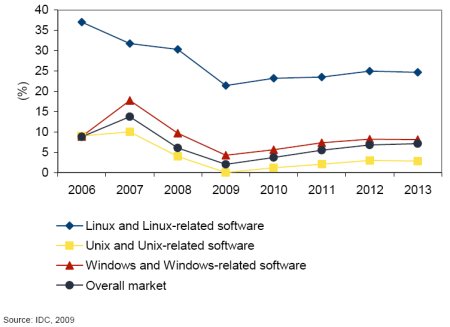Linux spending will defy recession, IDC claims
Apr 13, 2009 — by Eric Brown — from the LinuxDevices Archive — 5 viewsIDC is projecting that spending on Linux-related software will grow 21 percent this year, and 23.6 percent through 2013, compared to two- and five-percent growth, respectively, for the general software market. Sponsored by the Linux Foundation, the study sees the recession, virtualization, and cloud computing as key drivers behind Linux.
While overall growth rates are down, largely due to the recession, Linux-related software is expected to grow at an annual rate of 23.6 percent in the next five years, compared to 6.6 percent for Windows and 1.8 percent for Unix, says the study (see chart below). However, Linux is still a relative pipsqueak compared to Microsoft Windows-related software, notes the research group.
While Linux-related software is projected to grow from $12.3 billion in 2008 to $35.5 billion in 2013, Microsoft is starting off at the $149 billion mark in 2008, and moving up to $206 billion. And the slower-growing Unix will still continue to dominate over Linux in five years, as its share is expected to grow from $69 billion to $74 billion in 2013.

Worldwide software revenue year-over-year growth rates 2006-2013 (Source: IDC)
(Click to enlarge)
Linux is ably exploiting the latest recession, just as it did the less severe downturn of 2001 and 2002, when many IT customers moved from Unix to Linux, says IDC. In addition to recession-fueled cost-cutting concerns pushing tech customers toward Linux, IDC sees Linux as being “highly compatible with two of the hottest trends in the industry: virtualization and cloud computing.” Not only is Linux inherently strong in these areas, but Linux virtualization solutions are seen as more attractive during a recession due to the more flexible pricing options typically available for Linux, in which there are few or no charges for adding additional replica copies of the host operating system (OS), says IDC. In the “cloud” space, meanwhile, customers are said to be turning to Linux both for its lower cost and greater customizability.
The recession, combined with a move toward virtualization, is slowing the growth in the server market in general, suggests IDC. Looking at the overall ecosystem, which includes hardware spending, Linux is growing at a nine percent 2009 rate, which is strong relative to the other OSes, but lower than was previously projected by IDC. Trends in server sales include a growing percentage of sales of commercial Linux server platforms compared to free open community-based offerings (see diagram farther below).
Whereas hardware/software server sales have led Linux revenue for most of the decade, starting next year the “application development and deployment software” category will account for a slightly larger chunk of the market, says the study (see chart below) Application software is also growing fast, meanwhile, and looks to match the application deployment and development percentages by 2013. In addition, expenditures on “Linux and open source services” are also expected to surge.

Worldwide Linux and open source software ecosystem revenue 2007-2012 (Source: IDC)
(Click to enlarge)
The traditionally strong position for Linux in web and general IT infrastructure workload will remain relatively static at a little over half of all Linux server deployments, as seen from 2002 to 2012, says the study. During the remaining portion of that period, however, Linux will see increased duty for database, enterprise resource planning, and other general processing applications, with those combined applications moving from a 13 percent growth rate to an 18.6 percent rate over the next few years. Most of this growth appears to be coming at the expense of Unix, rather than Microsoft deployments, says the study.
IDC did not break out embedded Linux revenue in the study. However, it appears that the embedded market is represented in several categories, primarily in the fast growing “application development and deployment software” category, as well as Linux services. In addition, IDC predicted future growth in “software appliances” as an opportunity for Linux. Turnkey software stacks that combine the OS, middleware, “other infrastructure software components,” and in some cases, even application software, are quickly replacing discrete software stacks, says the research firm.

Linux server and operating system growth, 1998-2008 (Source: IDC)
(Click to enlarge)
For further breakdown by software category IDC points to its related, recently published Linux study published on behalf of Novell. That survey came to similar conclusions about the positive prospects for Linux, suggesting that over half of the 300 IT executives interviewed were either “actively evaluating” or “accelerating adoption” of Linux on the desktop. Almost three quarters responded likewise for servers.
Although any study sponsored by organizations that are heavily invested in the topic should be allotted a proper degree of skepticism, IDC is generally one of the more well-respected research organizations. What's more, its upbeat prognostication for Linux appears to match recent anecdotal evidence, as well as the surprisingly positive earnings for Linux OS and services vendor Red Hat. In a recent eWEEK story on the topic, for example, it was suggested that IT executives are increasingly being asked to look for open source solutions wherever possible in order to cut costs.
Availability
The IDC white paper on the Linux market should be available for free download at the Linux Foundation, available here in PDF format.
This article was originally published on LinuxDevices.com and has been donated to the open source community by QuinStreet Inc. Please visit LinuxToday.com for up-to-date news and articles about Linux and open source.